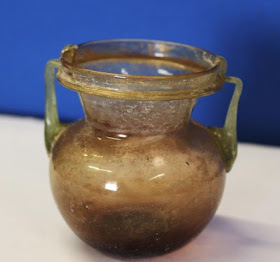Tuesday Times Tables: Glorious Roman Glass
Have you ever wondered how glass was made in the Roman period, or what the components of Roman glass are?
Glass has three
principal constituents: a former, a flux and a stabiliser. In antiquity,
silica, in form of sand, acted as the former; soda was used as flux and calcium
in form of lime was used as stabiliser.
The Roman glassworker could vary the
colour of the glass by adding specific metal oxides. Different quantities of
these colouring agents, that have different chemical compositions, and
manipulation of furnace temperatures produced a very wide range of translucent and
opaque colours.
The addition of copper produced a range of blues, greens and
red; cobalt was for dark blue; iron was used for brown and black glass;
manganese for yellowish or purple glass; and for the colourless or opaque white
glass was used antimony.
 |
| Roman melon bead made from glass paste |
The ingredients were
initially heated together to a temperature of about 600 Celsius degrees to
remove the impurities and this process, called “fritting”, produced the
material known as frit. The best of the frit was then broken up and heated to
1100 Celsius degrees or more to form glass.
 |
| Roman jar with thick zig-zag pattern from neck to shoulders |
The three principal
processes used to manufacture Roman glass vessels were casting, mould-blowing
and free-blowing.
 |
| Tall slightly twisted Roman jug with strap handle |
The casting was in
widespread use in the early years of Roman Empire, but became rare towards the
end of first century AD and occurred only occasionally thereafter. In the
casting process the glass objects were cast by directing molten glass into a
mould where it solidified. This technique created decorative effects by joining
together prefabricated component parts, like handles, feet and rims. The most
common cast vessel found in Roman Britain is the pillar-moulded bowl.
 |
| Modern glassmakers blowing glass |
By the time of the
Roman invasion of Britain in the reign of the Emperor Claudius in 43 AD, most Roman
glass was produced by the blowing method. The invention of glass-blowing
completely transformed the glass industry: it was now possible to produce a
wide variety of forms more cheaply.
It consists of an inflation of a gather (a mass of melted glass) onto the end of an iron rod.
The glass could be blown in a mould or with the free-blowing method, but in this
last case the glassworker had to shape the vessel by rolling the iron rod
across a flat stone or a metal surface and by manipulation with tools. When the
vessel was ready it was removed from the iron rod and then handles and other
parts were added.
Michela Amato
Collections Placement


